Hedebo embroidery is a type of whitework originating in Denmark, perhaps as early as the 15th century (according to Flora Klickmann in The Cult of the Needle).
Hedebo is unique style of whitework, in that it involves seven distinct types of stitched elements in its composition, each type being added to the general make up of Hedebo over time as Hedebo developed and evolved. What began as stylized, rather stiff geometric drawn thread embroidery eventually evolved in the early 1800’s to a freer type of openwork ornamented with satin stitch, cutwork, and needle lace.
Today, we associate Hedebo mostly with cutwork and needlelace, as these make up a recognizable part of most Hedebo embroidery.
Guida al Ricamo Hedebo, or Guide to Hedebo Embroidery, by Laura Marzorati and Stefania Bressan, is an excellent beginner’s guide to the basics (and beyond!) of Hedebo. Here’s a closer look at the book.
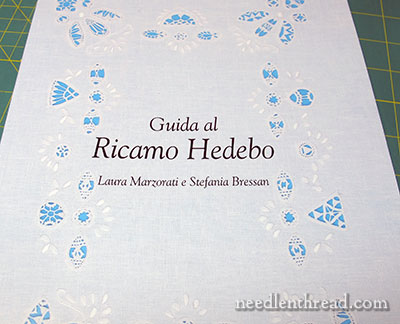
You might have noticed from the title that Ricamo Hedebo is an Italian book. And it’s true that the text is in Italian, but the book is so loaded with visuals in the form of diagrams and photos, that the techniques are easy to understand without a working knowledge of Italian.
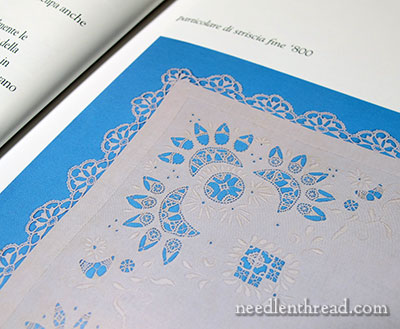
Scattered throughout the book, you’ll find many beautiful examples of Hedebo embroidery, stitched. I love the fact that the pieces were photographed against a blue background! It makes the whitework super white and clearly visible and the elements easy to discern.
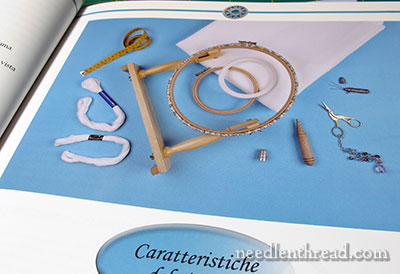
At the beginning of the book, you’ll find a section on materials required for Hedebo. Referring to the photo, the requirements are pretty simple and fairly standard. There is one unique tool (a Hedebo gauge) used for some elements in Hedebo embroidery – I’ll show you one up close a little later – but it isn’t absolutely essential.
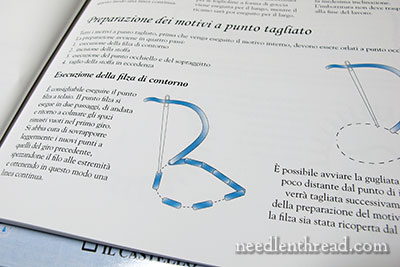
Then we get into the instructions on the basic stitches required in Hedebo, and you can see that the diagrams here, though simple, are very clear.
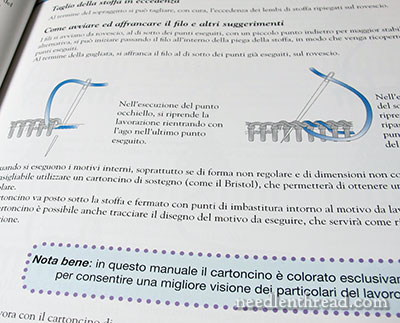
Every movement of all the required stitch elements are diagramed, so there’s no guessing.
Occasionally, you’ll find little “Nota Bene” messages in the text. Since these little reminders often point to something important, I translate them on a sticky note and stick it in the book, so I can note the point well when referencing the book in the future. You can easily translate little tidbits like this, using any online translator (like Google translate).
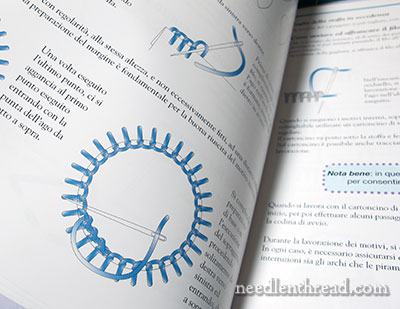
More examples of the diagrams – the buttonholed cutwork circle is used often in Hedebo…
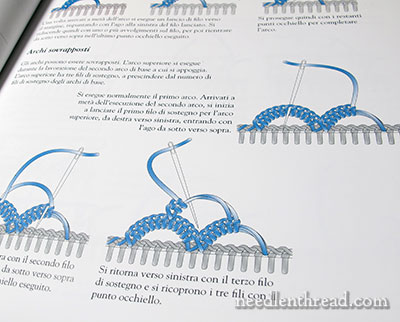
…and so are these wonderful scalloped edges.
This is one of the many things I really love about whitework and needle lace techniques:
Here we have some excellent instruction on scalloped edgings that are used in Hedebo embroidery. But there’s no restrictions on your use of these scalloped edges! You are perfectly free to use them in any type of embroidery. Needle lace and whitework techniques are made up of elements that translate well into many types of embroidery. So I never view a whitework or needle lace book purchase as “limiting” me to only one particular type of embroidery. With a little imagination, you can incorporate what you learn from whitework and needle lace instruction into all kinds of other embroidery applications.
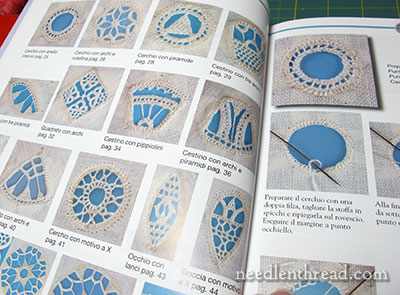
After the basics of Hedebo are covered via diagrams, we move into the photographs. And there are many!
The photos offer up-close, detailed, step-by-step instruction in the processes of Hedebo embroidery.
First, we’re presented with a pictorial index of the various needlelace elements typically found in Hedebo.
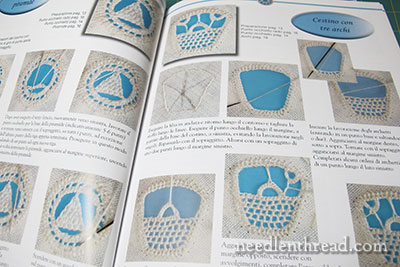
Then, each element is broken down into these step-by-step photos.
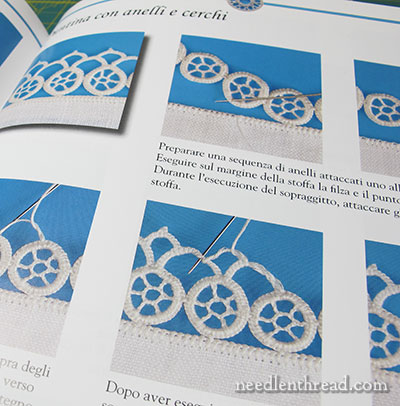
Other elements of Hedebo embroidery – like these wonderful detached rings that often ornament the edges – receive the same meticulous instructional treatment.
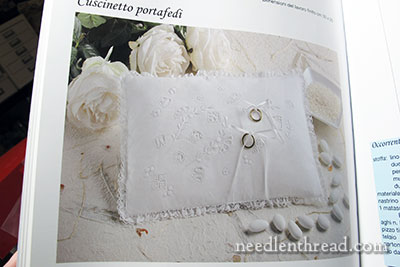
At the end of the book, there are several practice projects that include patterns, materials lists, and instructions. This ring-bearer’s pillow is gorgeous!
In a Nutshell
If you like whitework, cutwork, and needlelace, you’ll like the book!
Ricamo Hedebo is an excellent instructional book, perfect for beginners to this type of whitework embroidery. If you don’t read Italian, don’t worry – it’s not essential here. The diagrams and photos make the book perfectly accessible.
There aren’t a whole lot of books on Hedebo embroidery out there. I have two that I like – this one, and one in Japanese. (Thank goodness for photos!)
Where to Find It
You can find Ricamo Hedebo through the following book affiliates:
In the US, you can find a few used and new copies of Ricamo Hedebo on Amazon. Some are ridiculously priced, though!







Hi Mary,
What a timely post. I was just looking at this book yesterday as I would love to have a go at Hedebo. Where would we be without your wonderful reviews to show us what a book is really like?!
I just snatched up a $24 copy on Amazon. So excited to receive it! Thank you so much for bringing this – and so many other resources- to our attention. You are a gem!
Dear Mary
Hebebo embroidery looks interesting I really like cutwork and lace embroidery, I like the step by step photo instructions and the fact that the book is for beginners, the patterns are lovely and I especially like the ring-bearers pillow and as you say although it’s not in English you can google translate in English for the relevant written instructions, I can’t wait for the explanation of the Hebego gauge it looks interesting. certainly a must-have future book. Thanks for reviewing and sharing this lovely book.
Regards Anita Simmance
Wow! I am trying to finish a sampler from BATB 2012 and have been puzzling for several days about how to do the “Old Hedebo” part. Two of the stitches are called “reverse faggoting” and “Victorian chain stitch.” I haven’t found those in any of my references or online. And my photos haven’t helped. Maybe this book will. Thanks for the timely review!
RE: Guida al Ricamo Hedebo
You may wish to check out the site below if you do not know about it already.
http://www.barbara-fay.de/
The above is available at the shop. There is an extensive listing for embroidery books.
The daughter has taken over running the business for her mother. It has been around for a long time. There is a flat 5.00 euro air shipping for the US…any number of books for that price. No vested interest in the business except a very satisfied buyer.
Agree – Barbara Fay offers an excelllent service worldwide!
Thank you – I have just ordered a copy of the book.
What a gorgeous art form. I want that book, I really enjoy pouring over technique books in the evening. It helps my brain reset or something. The pictures and diagrams look well done. Let’s see where could I hide another book?
The Greve museum in Denmark has published books in Danish and in Danish & English about Hedebo. They have a catalogue from an exhibition that shows beautiful old Hedebo, and also an instructional book, with clear pictures and drawings, you can well manage without any text, really.
Also, on Youtube.com they have uploaded videos that show you how to do Hedebo embroidery. Look for Grevemuseum on You tube and you will find them.
Hi, Lilian! Thanks for the pointers. I have the Greve Museum already bookmarked – it’s a great resource for learning about Hedebo! ~MC
I just clicked on the link to Amazon.com. They show that they have 3 new copies in paperback for $24.95 each (not sure about the .95). That sounds like list price for a book that size. How many pages are in it?
Yes, that’s about the right price. It’s not a huge book (64 pages), but if it’s an import, so you’re actually paying the currency conversion price. ~MC
What appeals to me about whitework is it’s simple beauty. My family is a group of historical re-enactors and to be able to show this style to the public would be a wonderful example of the many styles of embrodery that most wouldn’t think about making.
Shoot, I didn’t put a solid name. Sorry!
Thank u for a clear description of whats in the book. A recommendation for beginners with many clear pictures of the steps for each stitch formation was very helpful.
please enter my name in the Hedebo book drawing. Thank you for a wonderful column on needlework. Sue
I love white work because it is first of all “simply beautiful” I like white work because I also love cut work… have done some on a machine but would like to try some simple design by hand…it just seems more authinic to me. While livin Holland I purchased some battenburg lace items and some bobbin lace products. To see the women work with both was sureal to me. I just admire the patience and detail of bobbin lsvr. I could go on all day with these lovely and happy memeories.
Thank you for sharing all this beautiful work.
Gwen Ziegler in Griffin Ga
What is it that appeals to you most about whitework embroidery?
The crisp, freshness is clearly seen whatever the thickness of thread or whether it is an elaborate or simple pattern design.
Regards
Jill
I am absolutely smitten with white work and cut work embroidery! This is an amazing book, and I’d have never heard of it without your review and email in my box today! What an amazing find! I’d be drooling for a week, if I won this book and would have to put off stitching until I got it under control!
Hello Mary, I have a book in Japanese about Hedebo – I wonder if it is the same as yours? Mine is by Yuki Pallis. I would love to try some Hedebo embroidery and I think I could follow the diagrams in this book if I had some recommendations about which fabrics and threads to use for the cutwork or drawn thread work – can you help please?
Hi, Laura, I think Alba Maxima by Legacy would be a good choice. Try Hedgehog Handworks for it.
Gosto muito desse bordado mas gostaria que tivesse mas aulas em português